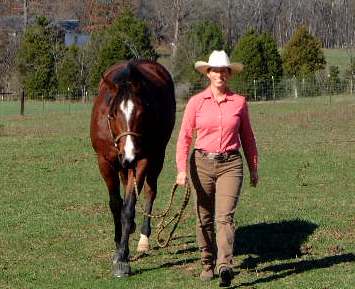 Leading is the act of a comparatively weak human guiding a potentially reactive and headstrong animal. It’s easy to see why it doesn’t always go well. Regardless of the pound-for-pound disadvantage, leading a horse can be easy – and it needs to be. Why? Because a horse that drags you to every clump of grass or leaves rope burns on your palms is not fun to deal with. A horse doesn’t lead well when he challenges your authority; either he feels insecure or he has a dominant personality that gets in his way. Whatever the underlying cause, your horse doesn’t perceive you as his leader and becomes a manner-less menace. Fortunately, you can transform your offender into a faithful follower using these 3 easy steps.
Leading is the act of a comparatively weak human guiding a potentially reactive and headstrong animal. It’s easy to see why it doesn’t always go well. Regardless of the pound-for-pound disadvantage, leading a horse can be easy – and it needs to be. Why? Because a horse that drags you to every clump of grass or leaves rope burns on your palms is not fun to deal with. A horse doesn’t lead well when he challenges your authority; either he feels insecure or he has a dominant personality that gets in his way. Whatever the underlying cause, your horse doesn’t perceive you as his leader and becomes a manner-less menace. Fortunately, you can transform your offender into a faithful follower using these 3 easy steps.
Step 2. Exploit your horse’s natural instincts. Teach your horse to read your body language in the same way he would if he were tracking a higher-ranking member of the herd. Horses expect their leader to focus on the path ahead, so always face the direction you want your horse to go. Imagine a laser pointer coming out of your chest that illuminates the path in front of you. For a right hand turn, point your chest to the right a moment before you change direction to alert your horse. Do the same for a left hand turn. If he doesn’t turn, use lead pressure to push his head into the direction of the turn. Add a hand on the side of his shoulder if he needs further encouragement to step away from you. The cue to stop is to pivot toward your horse, shining your imaginary laser light on the point of his shoulder. Make the turn slowly enough to give him a chance to respond. If he doesn’t stop, choke up on the lead placing your hand near the clip. Move him backward on a straight line by applying strong steady pressure. If he doesn’t respond to that, add pressure against his chest with your fingertips. Shudder the line if you need more emphasis to get your point across.
Step 3. Be a fabulous leader! It’s your responsibility to give your horse what he needs to be well-mannered while being led.
- Calmness. A competent leader is tranquil. A rise in your energy level will elevate your horse’s anxiety and he will feel less safe and willing to accept your directions.
- Confidence. Your horse will pick up on any feelings of insecurity that you have. Once you believe you are a capable herd leader, your horse will believe it too.
- Consistency. Give clear and easy to understand cues that remain constant from day-to-day. This simplifies the process for your horse and makes it easier for you to create positive changes in his behavior.
Liked this article? Here are others you’ll enjoy:
Groundwork for Young Horses
A Guide to Showmanship






Sure got a smile of the opening few sentence….how true. I am going to reread and then practice.
i agree
good article. I can use this with both horses I have…
Didn’t know that was the cue for the stop. Good to know!